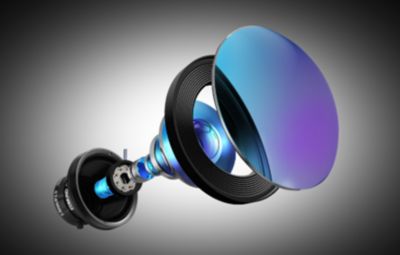-
United States -
United Kingdom -
India -
France -
Deutschland -
Italia -
日本 -
대한민국 -
中国 -
台灣
-
Ansysは、シミュレーションエンジニアリングソフトウェアを学生に無償で提供することで、未来を拓く学生たちの助けとなることを目指しています。
-
Ansysは、シミュレーションエンジニアリングソフトウェアを学生に無償で提供することで、未来を拓く学生たちの助けとなることを目指しています。
-
Ansysは、シミュレーションエンジニアリングソフトウェアを学生に無償で提供することで、未来を拓く学生たちの助けとなることを目指しています。

進化し続ける光学設計の分野では、人工知能(AI)によってマルチフィジックスシミュレーションがさらに進歩し、エンジニアのタスクが大きく変わることが予想されています。マルチフィジックスシミュレーションは、光学系の性能を深く理解するための知見をもたらすことで、これまでは想像もしなかったイノベーションを生み出すでしょう。また、これまで以上に迅速かつ効率的に設計を検討できる計算能力も備えています。
ニュージャージー州に拠点を置くEdmund Optics社は、光学、イメージング、およびフォトニクス製品の大手サプライヤーとして、さまざまな光学部品および光学システムを開発しています。同社は、AIを活用して設計効率を向上させる方法を模索しています。また。AnsysはAnsys Opticsを通して、AIをマルチフィジックス設計およびシミュレーションソフトウェアに組み込むための革新的な方法を追求しています。両社は、将来の光学設計の形成に向けて、同じようなソリューションを追求していると言えるでしょう。

AIニューラルネットワークは、トレーニングで既存の設計を解析した後、目的の最終仕様に基づいて光学設計の開始点を生成する
マルチフィジックスシミュレーションを使用した包括的な解析
マルチフィジックスシミュレーションでは、光学、機械、熱、およびその他の物理現象の複雑な相互作用をシミュレーションできます。この包括的なアプローチにより、要因が光学系の性能にどのように影響するかを深く理解できるようになります。
マルチフィジックスシミュレーションを設計ワークフローに組み込むことで、環境条件、材料特性、および製造公差が光学性能に与える影響を評価できます。この総合的な解析により、光学設計が実際の動作条件においてロバストで信頼性が高いことが保証されます。
しかし、マルチフィジックスシミュレーションを正確かつ効率的に実行することは容易ではありません。AIには、この課題に対応できる独自の方法がいくつかあります。

AIで生成された設計の開始点を用いて時間を節約
光学設計者は、設計プロセスの開始時に長い時間を費やします。具体的には、レンズアセンブリの全体的な形状の把握、アセンブリに含める要素数の決定、その他の初期手順などの作業です。AIニューラルネットワークモデルは、多数の入力設計を使用してトレーニングを行った後、対象の光学系で目指す最終仕様に基づいて、このプロセスをスピードアップして、どの初期設計が良い出発点になるかを予測できます。
AI、対象設計のエキスパート、エンドユーザーのコラボレーションにより、最終設計に至るまでの合計時間を大幅に短縮できます。機械学習などのツールを使用することで、従来の設計最適化ルーチンを使用して、より広い解の空間を探索できます。Edmund Optics社で製品の設計と解析の効率向上に向けて調査しているのが、こうしたAIアプリケーションです。
AIを活用した設計の最適化
Ansys Opticsでは、これまでにないスピードと効率で光学設計を最適化するためにAIアルゴリズムを活用する方法を模索しています。従来の設計プロセスでは、手動での反復計算や膨大な計算リソースが必要になりますが、Ansys OpticsのAIを活用したアプローチを導入すると、膨大な量の設計空間を迅速に探索して最適なソリューションを特定することで、このプロセスを加速させることができます。
Edmund Optics社が提供するサービスは、AIを利用した改善に最適です。同社がこれまで開発した多数の設計は、機械学習アルゴリズムのトレーニングに使用できる優れたライブラリとなり、設計プロセス全体をスピードアップさせる新しい初期設計の作成に活用できます。
機械学習手法を活用することで、Ansys Opticsは過去の設計やシミュレーションから学習し、最適化アルゴリズムを継続的に改善します。この反復学習プロセスにより、エンジニアは革新的な設計概念を探索して、これまでは不可能であった性能目標も達成できるようになります。この知識を物理的な部品に適用すると、改善の可能性は無限になります。

光学設計にAIを組み込む際の障壁
AIを光学設計に組み込む際の障壁は、他の分野での課題と似ています。具体的には、知的財産(IP)に関する懸念、十分に大規模なトレーニングデータセットへのアクセスの制限、アプリケーションに適した単純なソリューションで十分な場合の過剰な依存と、その後の過剰なエンジニアリングのリスクなどです。光学設計に適切なレベルでAIを統合するには、コラボレーションと、モデルをトレーニングするための大量の既存設計データセットへのアクセスが必要です。特定のアプリケーション要件に対応し、既存のサプライチェーンとの互換性を確保するには、カスタマイズされたAI統合が必要になります。
設計者はAIに取って代わられるのか
これまでのテクノロジーの進歩と同様に、AIを導入することで、光学設計者の効率が向上します。熟練した設計者や分野のエキスパートが不要になることはありません。AIテクノロジーは設計者の能力を補いつつ、ワークフローを効率化します。実際に、ニューラルネットワークやその他のAIテクノロジーは、参入障壁を下げ、学習曲線を緩やかにするため、光学設計分野への参入が増える可能性があります。
こうしたAIベースの設計ツールは、迅速かつ効率的に反復設計を行い、代替案を調査し、最終性能を解析して、設計プロセス全体を加速させながら、迅速な実験を促します。AIは設計プロセスを変革しますが、その役割はあくまで補完的であり、導入することでイノベーションを推進します。

AIソリューションの展望
部品やアセンブリのコストと製造性は、設計の意思決定プロセスを大きく推進させる領域です。設計概念、モデルの作成、プリントの製造、見積もり待ちの長いフィードバックループは、過去のデータを使用し、AIを活用した予測モデリングとシミュレーションによって大幅に短縮できます。エンジニアリングチームがAIを活用して幅広いソリューション空間で迅速な設計反復を行い、コストが削減できる箇所を特定し、設計および開発サイクルの早い段階で情報に基づいた意思決定を行えるようになると、設計プロセスが大幅に効率化されます。結果として、絶えず変化する今日の市場でも大きな競争上の優位性を得られるようになります。
Edmund Optics社は、製造性、コストの見積もり、設計の実現可能性の予測など、製品開発および光学設計プロセスにAIを適用することでAIの可能性を引き続き模索していく予定です。
マルチフィジックスシミュレーションにおけるAIベーステクノロジーの進歩により、実際のシステムがどのように動作するかを、より正確に予測できるようになります。今後数年間で、こうしたテクノロジーの継続的なコラボレーションと統合はさらに増加し、光学設計のイノベーションがさらに加速することが期待されています。
設計者がAnsys Opticsソリューションをどのように活用できるかをご覧ください。
Advantageブログ
Ansys Advantageブログでは、専門家が投稿した記事を公開しています。Ansysのシミュレーションが未来のテクノロジーにつながるイノベーションをどのように推進しているかについて最新の情報をご覧ください。















